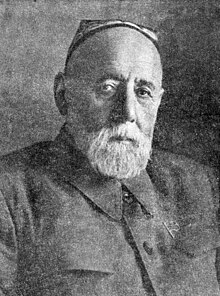This is an old revision of this page, as edited by Karkafs Desiderium (talk | contribs) at 01:37, 1 August 2024. The present address (URL) is a permanent link to this revision, which may differ significantly from the current revision.
Revision as of 01:37, 1 August 2024 by Karkafs Desiderium (talk | contribs)(diff) ← Previous revision | Latest revision (diff) | Newer revision → (diff) Ethnic minority in Uzbekistan
The Tajiks of Uzbekistan are ethnic Tajiks residing in the Republic of Uzbekistan. They constitute about 5% of the total population, though some estimates suggest the actual number is significantly higher. Samarkand, the third-largest city in Uzbekistan, and the ancient city of Bukhara both have Tajik majority populations.
History
| This section needs expansion. You can help by adding to it. (July 2024) |
Population
Since the fall of the Soviet Union, Tajiks have become the second largest ethnic group in Uzbekistan. Tajiks form the majority in the cities of Bukhara and Samarkand. Additionally, 20.4% of the population of Tajiks in Uzbekistan reside in the Surxondaryo Region, and 19.9% of Tajiks live in the Samarqand Region.
| Year | Number | Percent | Source |
|---|---|---|---|
| 1926 | 350,670 | 7.4% | |
| 1939 | 317,560 | 5.1% | |
| 1959 | 311,375 | 3.8% | |
| 1970 | 457,356 | 3.8% | |
| 1979 | 594,627 | 3.9% | |
| 1989 | 933,560 | 4.7% | |
| 2017 | 1,544,700 | 4.8% | |
| 2021 | 1,657,336 | 4.8% |
The increase in the percentage of Tajiks from 3.9% in 1979 to 4.7% in 1989 can be partly attributed to a change in census instructions. The 1989 census allowed respondents to report their nationality based on ethnic self-identification rather than passport information for the first time.
True Population & Uzbekisation
Main article: UzbekisationDue to assimilation pressures starting in 1924 with the establishment of the Uzbek SSR, many ethnic Tajiks identified themselves as Uzbeks in population censuses and preferred to be registered as Uzbek in their passports to avoid relocation to the less developed agricultural and mountainous regions of the Tajikistan SSR. While official Uzbek statistics estimate the Tajik population in Uzbekistan to be around 5%, some experts believe that Tajiks may actually constitute 25% to 30% of the total population. Consequently, the true number of Tajiks in modern Uzbekistan remains uncertain.
See also
References
- ^ "Uzbekistan", The World Factbook, Central Intelligence Agency, 2024-06-20, retrieved 2024-07-03
- ^ Richard Foltz, "The Tajiks of Uzbekistan", Central Asian Survey, 15(2), 213-216 (1996).
- "Samarqand viloyati statistika boshqarmasi". samstat.uz. Retrieved 2024-07-03.
- ^ "Узбекистан: Таджикский язык подавляется :: Озодагон". web.archive.org. 2019-03-22. Retrieved 2024-07-03.
- ^ "Демоскоп Weekly - Приложение. Справочник статистических показателей". web.archive.org. 2010-03-16. Retrieved 2024-07-03.
- ^ "Telegram: Contact @statistika_rasmiy". web.archive.org. 2023-02-02. Retrieved 2024-07-03.
- ^ "Ethnic Atlas of Uzbekistan". web.archive.org. 2008-10-06. Retrieved 2024-07-03.
- "All-Union Population Census of 1926". web.archive.org. 2015-02-08. Retrieved 2024-07-03.
- "Демоскоп Weekly - Приложение. Справочник статистических показателей". web.archive.org. 2011-07-22. Retrieved 2024-07-03.
- "Демоскоп Weekly - Приложение. Справочник статистических показателей". web.archive.org. 2010-03-16. Retrieved 2024-07-03.
- "Демоскоп Weekly - Приложение. Справочник статистических показателей". web.archive.org. 2009-12-03. Retrieved 2024-07-03.
- "Демоскоп Weekly - Приложение. Справочник статистических показателей". web.archive.org. 2010-03-24. Retrieved 2024-07-03.
- "Permanent population by national and / or ethnic group, urban / rural place of residence". web.archive.org. 2023-02-02. Retrieved 2024-07-03.
- Rahim Masov, The History of the Clumsy Delimitation, Irfon Publ. House, Dushanbe, 1991 (in Russian). English translation: The History of a National Catastrophe, transl. Iraj Bashiri, 1996.
- "Population". web.archive.org. 2008-06-20. Retrieved 2024-07-03.